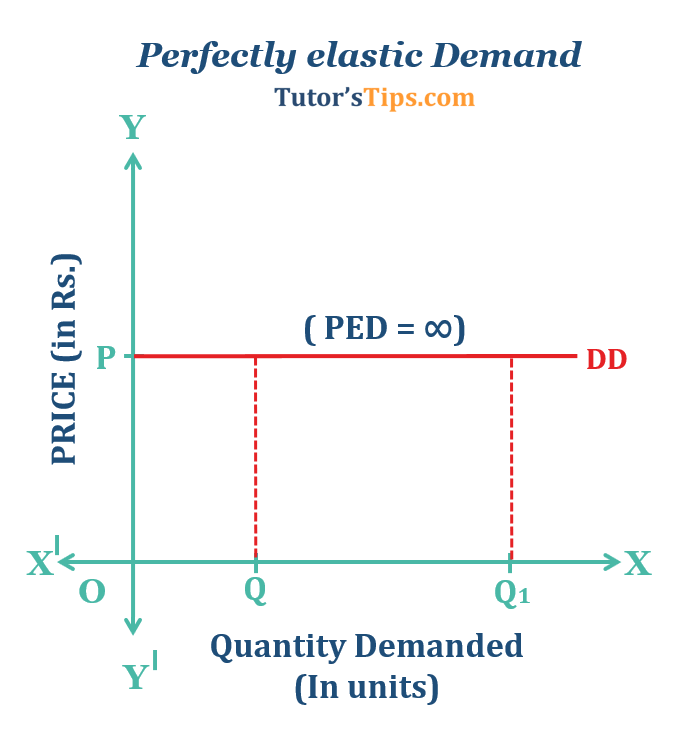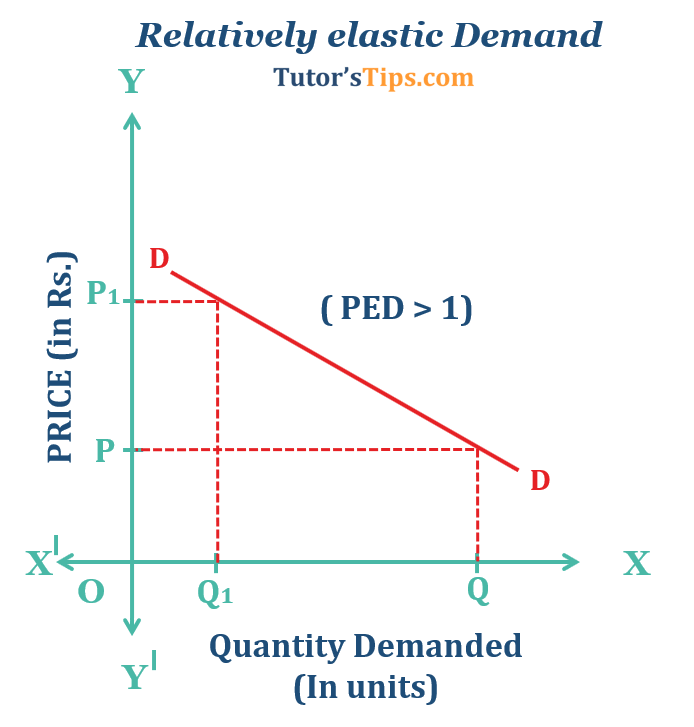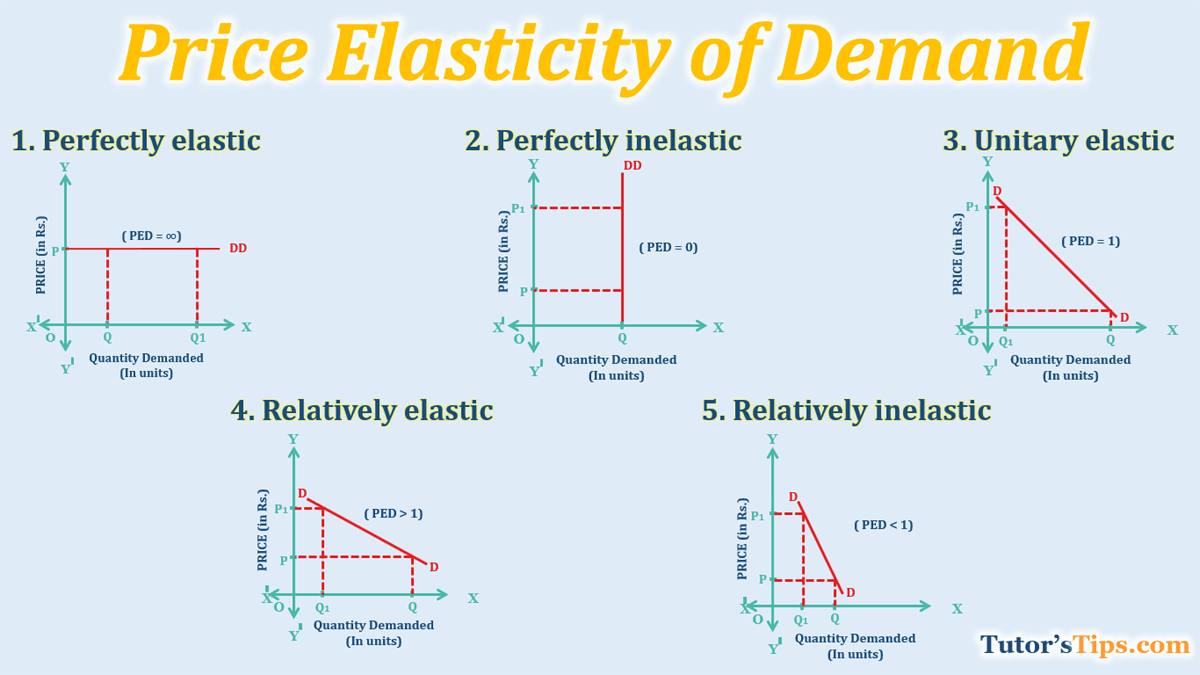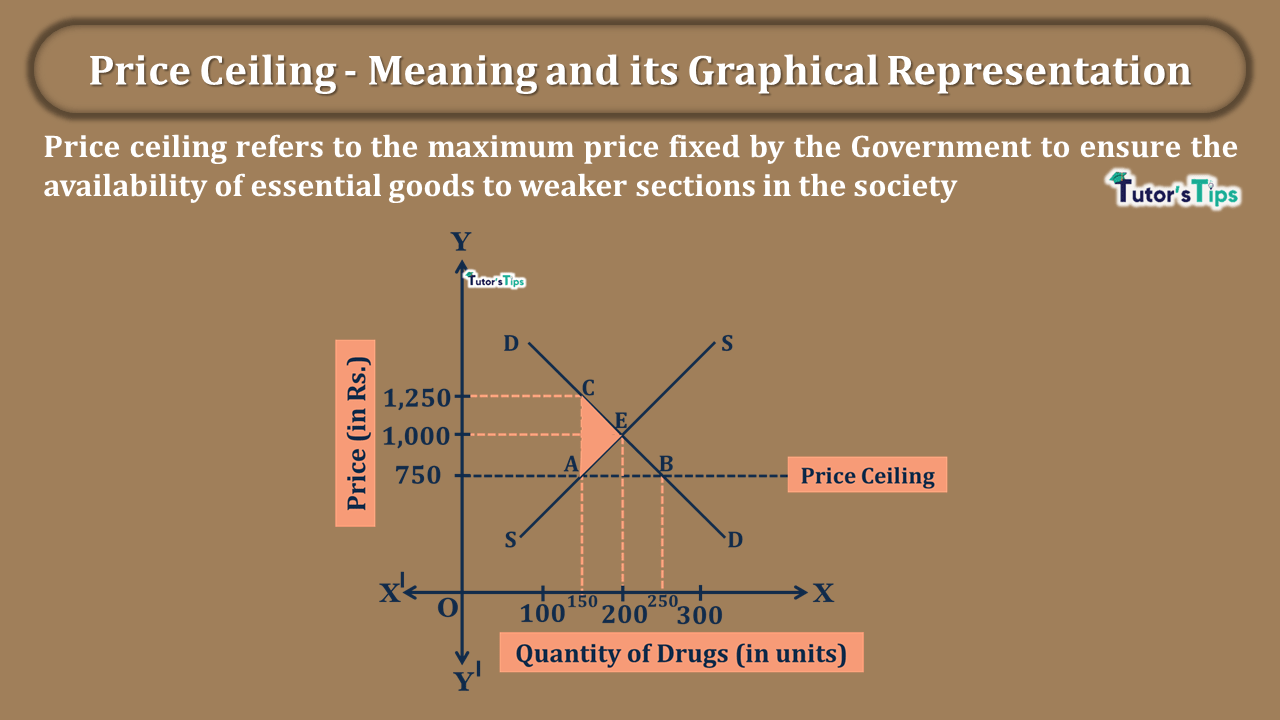The Price Elasticity of Demand is the measurement of the degree of change in demand in response to a change in its own price of the commodity.
What is Price Elasticity of Demand?
Price elasticity of demand (PED) refers to the degree of responsiveness of quantity demanded with respect to change in the price of that particular commodity, other things remain constant.
Formula to calculate Price Elasticity of Demand:
It can be calculated as the percentage change in quantity demanded divided by the percentage change in price.
% Δ quantity demanded = percentage change in quantity demanded
% Δ Price = percentage change in price
Example of Price Elasticity of demand:
The price of a commodity falls from Rs 20 per unit to Rs 15 per unit and due to this, the quantity demanded of that commodity increases from 100 units to 150 units.
Then, The price elasticity can be calculated as:
The Percentage change in demand = (change in demand/ original demand) *100
= (50/100) *100 =50%
Percentage change in price = (change in price/original price) *100
Advertisement-X
= (5/20) *100 =25%
Price elasticity of demand = 50/25 = 2
It means the quantity demanded increased by 2 times due to fall in price by Rs 5.
Types or Degrees of price elasticity of demand:
- Perfectly elastic
- Perfectly inelastic
- Unitary elastic
- Relatively elastic
- Relatively inelastic
1. Perfectly elastic ( PED = ∞):
The demand is said to be perfectly elastic when a small rise in price would result in a fall in demand to zero, while a small fall in price results in demand to become infinite. Therefore, It is also known as infinite elasticity. It is a theoretical concept only as it has no importance in the practical world.
This can be shown by a straight-line demand curve parallel to the horizontal axis.
Example:
Suppose the price of a commodity is rs 10 and its demand is 50 units. As the price falls to Rs 9, its demand increases to infinity.

In fig, the x-axis shows the quantity demanded and the y-axis shows the price. Dd curve is the demand curve. The initial demand at price P is Q units. When the price is slightly decreased, it leads to an increase in demand by a large amount i.e. Q1. It shows a perfectly elastic demand.
2. Perfectly inelastic (PED=0):
When demand doesn’t change with change in price( whether rising or fall), then demand is said to be perfectly inelastic. It implies that the demand remains constant for any value of the price. Hence, It is rarely found in real but the closest example we can take is water and other necessity goods.
It is represented by a straight line parallel to the vertical axis.
Example:
Suppose the price of a bottle of water is Rs. 15 and its demand is 200 units. As the price increases to Rs 20, the demand remains constant at 200 units. It implies the demand is perfectly inelastic.
Advertisement-X

In fig, the x-axis shows the quantity demanded and the y-axis shows the price. Dd is the demand curve. At the price P, the quantity demanded is Q units. As the price increases to P1, there is no effect on the quantity demanded. It remains constant at the initial quantity Q. This implies that the demand is perfectly inelastic.
3. Unitary elastic ( PED = 1):
The demand can be said as unitary elastic when the percentage change in quantity demanded is equal to the percentage change in price. It is also known as unitary elasticity. It is an imaginary concept as rarely found in the practical world.
Example:
Suppose, the price of a commodity is Rs. 50 and the quantity demanded in a specific market is 200 units. As the price increases to Rs. 60, its demand declines to 160 units. It implies the unitary elastic demand.

In fig, the X-axis shows the quantity demanded and the Y-axis shows the price. Dd is the demand curve. At the price P, the quantity demanded is Q units. As the price increases to P1, the quantity demanded decreases to Q1 by an equal proportion. It implies that the demand is unitary elastic.
4. Relatively Elastic ( PED > 1):
Relatively elastic demand occurs when a proportionate change in demand is greater than the proportionate change in price. It means that there will be a greater change in demand due to a small change in price. It is also known as highly elastic demand and more than unitary elastic demand.
Example:
Suppose, the price of a commodity is Rs. 40 and the quantity demanded is 20 units. As the price declines to Rs 30, its demand increases to 30 units. It implies a relatively elastic demand.

In fig, the X-axis shows the quantity demanded and the Y-axis shows the price. Dd is the demand curve. At the price P, the quantity demanded is Q units. As the price is increased to P1, the quantity demanded is decreased to Q1 units. Here, the change in price is less than the change in quantity demanded. Therefore, it can be said as perfectly elastic demand.
5.Relatively inelastic demand ( PED <1):
The demand can be said as relatively inelastic when a proportionate change in quantity demanded is less than proportionate change in price. It means that the greater change in price leads to a smaller change in demand.
Example:
Suppose, the price of a commodity is Rs 10 and the quantity demanded is 20 units. As the price increases to Rs 15, the quantity demanded declines to 15 units. It implies a relatively inelastic demand.

In fig, the X-axis shows the quantity demanded and the Y-axis shows the price. Dd is the demand curve. At the price P, the quantity demanded is Q units. As the price increases to P1, the quantity demanded falls to Q1 units. Here, the change in price is more than the change in quantity demanded. Therefore, it shows a relatively inelastic demand.
Advertisement-X
Factors affecting Price Elasticity of Demand:
1)Nature of Commodity :
The price elasticity of demand varies with the nature of the commodities. Ordinally, the price elasticity of demand for necessity goods like salt, sugar, matchboxes etc. is less than unity. It is because any change in the price of these commodities doesn’t affect the demand as consumers will buy these commodities irrespective of change in price. On the other hand, the price elasticity of demand for luxury goods such as gold, jewellery and air conditioner etc. is greater than unity. It implies that a little change in the price of these commodities has a great impact on their demand. Whereas the price elasticity of demand for comfort goods like milk, fans etc is unity implying an equal proportionate change in the demand due to changes in price.
2) Availability of Substitutes :
Commodities having substitutes available in the market at reasonable prices have elastic demand. Substitute goods refer to the goods which can be used in place for each other such as tea and coffee, Oreo and Hide n Seek Biscuits, sandals and chappals etc. A little fall in the price of one substitute goods results in more demand for it. Consequently, the demand for substitute goods is elastic. For instance, if the price of tea falls, people will start demanding more of it whereas less of coffee. On the other hand, goods with no substitutes have inelastic demand.
3) Goods with different Uses :
Goods which can be used for many purposes contain elastic demand. A rise in the price of a commodity leads to a decrease in the usage of that commodity. For Example, the milk is used to drink and to make tea, cheese, curd and lassi. If the price of milk is increased, it will be used for drinking purpose only and so its demand for other less essential uses will fall considerably.
4) Income of consumer:
The price elasticity of demand varies with the income of the consumers. For the high and low-income group, the demand is inelastic whereas, for middle-income group people, the demand is elastic. This is so because any change in price leads to contraction or extension of demand by middle group people. On the other hand, it has very little effect on the demand for high and low-income group people.
5) Habit of Consumers:
The goods like cigarettes, alcohol, coffee etc. for which consumers become habitual, have inelastic demand. Any change in the prices of these commodities results in no change in its demand.
6) Price Level:
The commodities having high prices such as jewellery, air conditioners, gold and low prices like newspapers have inelastic demand. The change in prices of these commodities leads to a little change in demand. On the other hand, medium-priced goods such as clothes, television etc have elastic demand. A little change in the prices of these goods has a great impact on their demand.
7) Time Period:
Demand for any commodity is inelastic for a shorter period of time whereas elastic for longer period of time. This is so because the tastes, preferences and habits of consumers change in long run. In other words, the rise in the price of a commodity will lead to contraction of demand and Fall in price leads to an extension of demand in long run.
8) Joint Demand:
The complementary goods such as car and petrol, ink and pen, camera and film etc. have inelastic demand. A rise in the price of petrol may not contract if there is no fall in the demand for cars.
9) Peak and Off-Peak demand :
The demand for commodities during peak times is inelastic and during off-peak times, it is more elastic. This pattern is particularly applicable in the case of transport and hotels accommodation facilities.
10) Proportion of Income Spent on a commodity :
The commodities such as toothpaste, boot polish etc. on which a small proportion of income is spent have inelastic demand. Any change in the price of these goods doesn’t affect their demand whereas for the goods on which a large proportion of income is spent, have elastic demand such as clothes, food etc.. The change in prices of these goods has great impact on its demand.
Advertisement-X
11) Postponement of Use :
The commodities for which demand can be postponed, have elastic demand. For instance, if demand for building houses is postponed then demand for building material such as bricks, cement lime and sand etc will become elastic. On the other hand, the commodities for which demand cant be postponed like food when hungry or drink when thirsty, have inelastic demand.
Thanks, Please share with your friends this topic
Comment if you have any question.
Introductory Microeconomics – Class 11 – CBSE (2020-21)








1 Comment